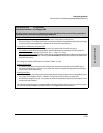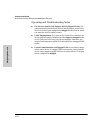
6-146
Configuring the Switch
Class of Service (CoS): Managing Bandwidth More Effectively
Configuring the Switch
IP Multicast (IGMP) Interaction with CoS
The switch’s ability to prioritize IGMP traffic for either a normal or high
priority outbound queue overrides any CoS criteria, and does not affect any
802.1p priority settings the switch may assign. For a given packet, if both IGMP
high priority and CoS are configured, the CoS configuration overrides the
IGMP setting.
Summary of CoS Operation
Each of the following four tables provide a hierarchy of CoS criteria and
resulting operation, based on one of the four possible tagged VLAN scenarios
a packet can encounter while traversing the switch. These scenarios include:
■ The packet enters the switch and exits from the switch on a non-VLAN
or untagged VLAN port.
■ The packet enters the switch in an untagged VLAN and exits from the
switch in a tagged VLAN.
■ The packet enters the switch in a tagged VLAN and exits from the
switch in an untagged VLAN.
■ The packet enters the switch and exits from the switch in a tagged
VLAN.
In each scenario, only the first CoS criteria that applies to a packet is used.
All others are ignored.
IGMP High Priority
Configured
CoS Configuration
Affects Packet
Switch Port Output
Queue
Outbound 802.1p
Setting (Requires
Tagged VLAN)
Not Enabled No Normal Same as Inbound
Setting
Not Enabled Yes: High Priority
(4 - 7)
High Configured by CoS
(4 - 7)
Not Enabled Yes: Normal Priority
(0 - 3)
Normal Configured by CoS
(0 - 3)
Enabled No High Same as Inbound
Setting
Enabled Yes: High Priority
(4 - 7)
High Configured by CoS
(4 - 7)
Enabled Yes: Normal Priority
(0 - 3)
High Configured by CoS
(0 - 3)


















